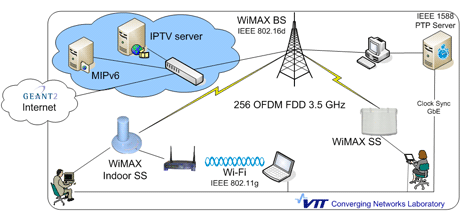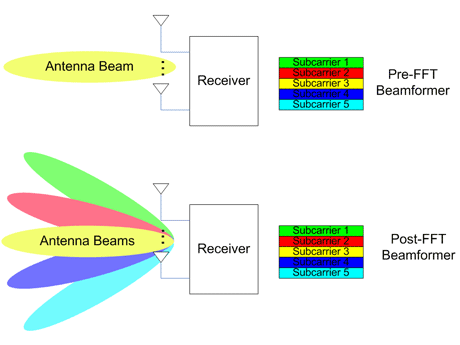WiMAX, often cited as technology that could serve as the substrate for next-generation mobile broadband networks, stands for Worldwide Interoperability for Microwave Access and is based on IEEE 802.16 standards. WiMAX networks can provide point-to-point and point-to-multipoint broadband IP connectivity to both fixed and mobile hosts, with Quality of Service (QoS) guarantees and robust security.
In theory, and according to vendor field trials and demonstrations, WiMAX can deliver cell bitrates greater than 100 Mb/s, covering large areas (up to 50 km radius from a single base station site using directional antennae), and serving tens of subscribers. These are impressive figures. However, the currently available, commercial off-the-shelf (COTS) equipment delivers significantly less application-layer throughput. At VTT we empirically evaluated fixed WiMAX, aiming to improve our understanding of what is realistically possible using COTS equipment. In particular, we employed the VTT Converging Networks Laboratory (CNL) infrastructure, which includes a fixed WiMAX base station (BS) and two subscriber stations (SS), and studied Voice over IP (VoIP) and live IPTV streaming uplink and downlink performance (see Figure 1). Fixed WiMAX was used both as backhaul for voice and data services as well as a last-mile network access technology. CNL is connected via GEANT2 to the Internet.
We employed multiple competing traffic sources over a point-to-multipoint WiMAX topology; its capacity was measured in terms of number of synthetic bidirectional VoIP 'calls' between subscriber stations while concurrently delivering a variable number of video streams with negligible loss. For VoIP, we considered several scenarios using both Speex and G.723.1 codecs. The video stream was captured from a live TV channel transmission and retransmitted in H.264/AVC format.

We measured throughput, packet loss and one-way delay for both line-of-sight (LOS) and non-line-of-sight (NLOS) conditions. We also calculated mean opinion scores (MOS) based on the ITU Telecommunication Standardization Sector (ITU-T) E-model, for the experiments with G.723.1. We accurately measured one-way delay by employing a software-only implementation of the IEEE 1588 Precision Timing Protocol (PTP). Finally, in order to put our results in perspective, we repeated the measurements after adding IEEE 802.11g access points (APs) in the topology of Figure 1. We found that VoIP flows carrying single sample payloads are clearly underperforming and that application-layer VoIP aggregation can more than triple the number of lossless VoIP flows in the downlink without any network or hardware support. Moreover, our results indicate that a single WiMAX subscriber station can backhaul VoIP traffic from at least two Wi-Fi APs. Due to space constraints we cannot cover all our results in this article, and refer readers to the peer-reviewed publications available from the links below.
Besides empirically quantifying COTS WiMAX performance, we also used Monte Carlo simulations to study the performance of the WiMAX physical layer in more challenging radio environments. Radio channel properties in isolated mountainous areas differ significantly from those considered in the main target environments of the WiMAX system specifications. We therefore studied promising ways of compensating for performance loss due to environmental factors by steering the direction of the receiver antenna beams. First, the radio channel properties in the mountainous environment around the Vesuvius volcano in southern Italy were analytically derived based on the bistatic radar equation and the geological properties of the area. Careful analysis revealed that the presence of the mountain increases the length of the channel delay spread significantly as well as spreading the received signal in the spatial domain. This model was merged with the WINNER I channel model in Matlab in order to generate a model that could be used in computer simulations.

Consequently we studied the ability of several MIMO algorithms, especially the so-called pre- and post-FFT EVD (Fast Fourier Transform Eigenvalue Decomposition) beamformers, to compensate for performance loss caused by the long channel impulse response. While a pre-FFT EVD beamformer steers the whole receiving antenna beam to one direction, a post-FFT beamformer behaves in a frequency-selective manner and steers the receiver antenna beam for each Orthogonal Frequency Division Multiplexing (OFDM) subcarrier separately (see Figure 2). The simulation results demonstrated that both types of beamformer were able to compensate for the performance loss caused by the mountainous environment. However, the post-FFT EVD beamformer demonstrated superior performance at the cost of higher computational complexity and sensitivity towards implementation imperfections, such as inaccurate channel estimates.
The work described herein was mainly undertaken in the framework of WEIRD, a European 'Integrated Project' funded by the 6th Framework IST programme, which was briefly introduced in ERCIM News no. 73.
Links:
VTT Converging Networks Laboratory: http://cnl.willab.fi
IST WEIRD: http://www.ist-weird.eu
Related publications: http://ipv6.willab.fi/kostas/?weird
Please contact:
Kostas Pentikousis
VTT Technical Research Centre of Finland
Tel: +358 40 536 9052
E-mail: kostas.pentikousis![]() vtt.fi
vtt.fi










